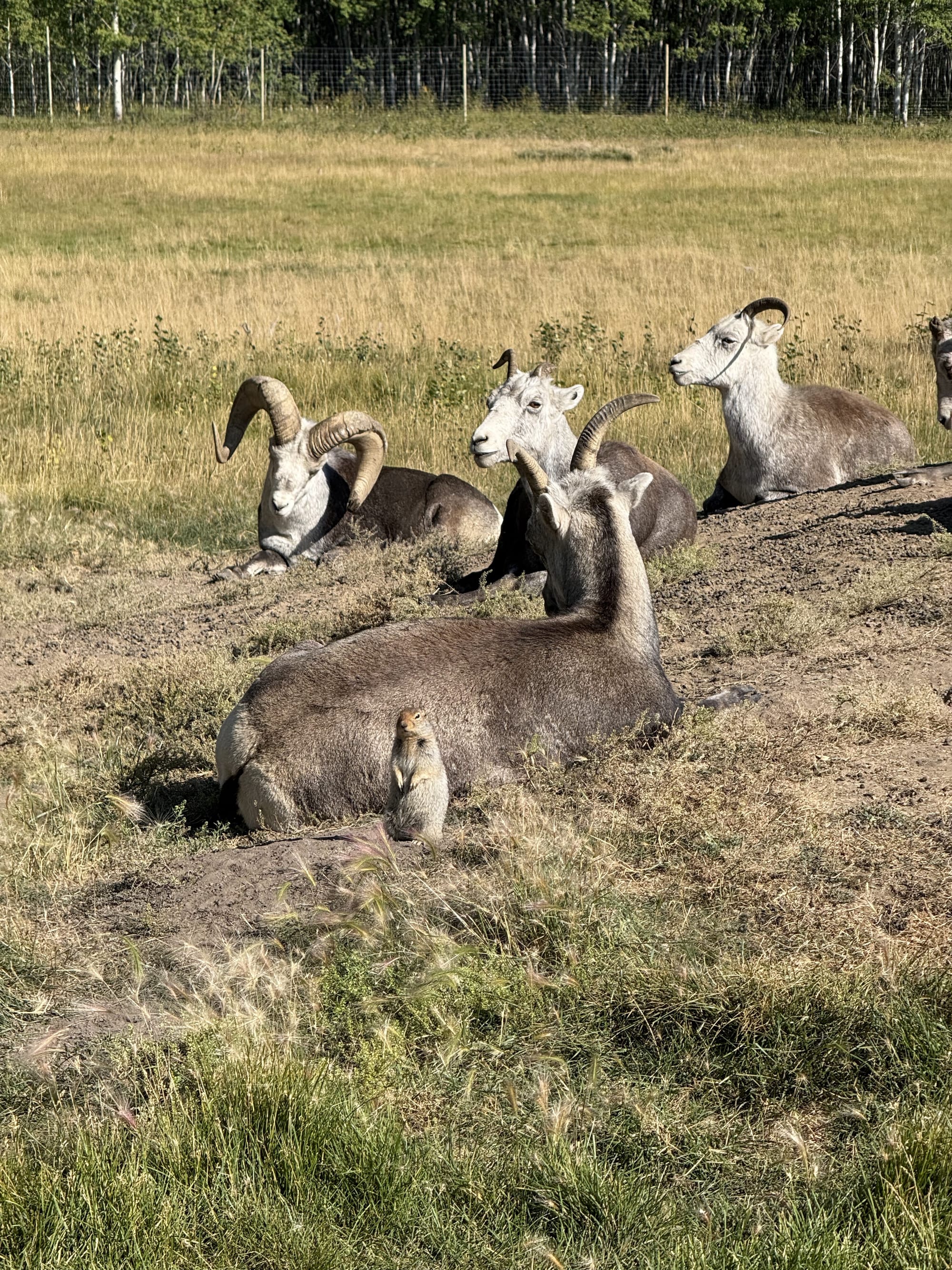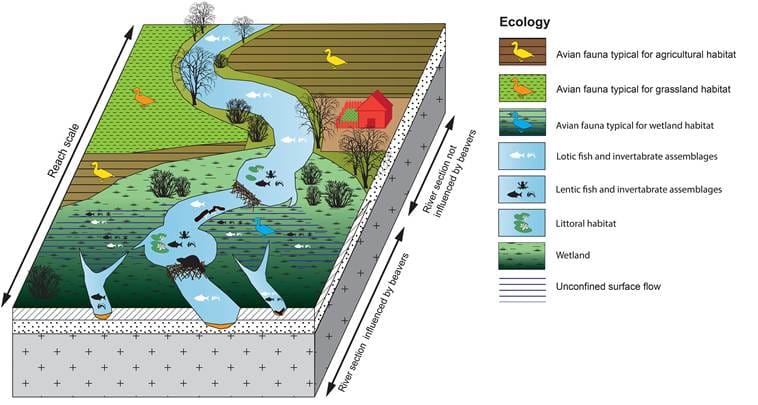Ecosystem Engineering: How Animals Positively Shape Their Environments
Animal ecosystem engineers modulate the availability of resources to themselves and other species by improving ecosystem structure and function, in the process consistently sequestering and storing more carbon.

On a fine day in early summer thirty years ago I launched my kayak into a bay behind a small community on the west coast of Vancouver Island. I hoped to see the foraging grey whale that the locals had reported was there, the first one that had been seen in that particular bay in over three decades. Ten minutes into my paddle, there was the whale, busily diving and surfacing.
Grey whales are baleen whales, filter feeders. They suck up a big plug of mud and water from the seafloor (the benthic zone), and then come to the surface, pushing the plug out with their tongues through their baleen to sieve out small crustaceans that live on or in the benthic zone. They leave a trail of muddy water behind them, take another deep breath, dive again, and repeat until they have run out of food in that area.
Grey whales are big, with typical adults reaching 13–15 m (43–49 ft) in length and 15 - 33 tonnes in mass, so when they feed they take a correspondingly big gulp of sea bottom. The question that occurred to me as I witnessed that behaviour the whole of that long afternoon, was what was all that excavation doing to the sea bottom ecosystem? The answer is the excavations are making the ecosystem more fertile. The feeding whales break up mats of bottom tube-dwelling amphipods, gouging big holes that are then re-colonized by a more diverse set of organisms.1 The whole cycle is more complex than that, of course, but the bottom line (pun intended) is that the benthic zone is more productive for both the whales and for other species because the whales are present, feeding the way they do.
Whales are not the only animals that make the ecosystem they inhabit more productive. Many animals are considered to be ecosystem engineers who, through their behaviour, “regulate energy flows, mass flows, and trophic patterns in ecosystems”2 (trophic = any step in the food chain of an ecosystem) in a kind of virtuous cycle that not only makes the environments they inhabit more productive for themselves, but also for other species. Further, those changed ecosystems can sometimes exert selection pressures that affect the evolution of the ecosystem engineer animals themselves (a concept known as niche construction, and beyond the scope of this article).
On the west coast of North America, another ecosystem engineering virtuous cycle example is one involving bears, Pacific salmon, salmon streams, and the forests the streams flow through. The cycle works like this: Pacific salmon (all five species) are anadromous, meaning the adult fish live in the ocean but return to freshwater streams to spawn and then die. Black, grizzly, and brown bears carry the fish they catch in the spawning streams into the forests alongside. The bears preferentially feed on the fattiest parts of the fish and leave the rest of the carcass to decompose. The fish bodies transfer significant quantities of marine nutrients to the forest ecosystem – especially nitrogen (a fertilizer), comprising up to 24% of riparian (land alongside streams, rivers and lakes) nitrogen budgets. The resulting enhanced growth helps stabilize stream banks and provides shade, which maintains cool water temperatures essential for salmon spawning and juvenile development. More juvenile fish means more adult fish, which return to feed more bears, and so on.3, 4, 5, 6
Every fall season in Africa, around 600,000 wildebeest7 begin to leave their calving grounds in the southern Serengeti of Tanzania, to begin the long clockwise migration to the north Serengeti and the Masai Mara area. Along the way the wildebeest, accompanied by smaller numbers of zebra and various species of gazelle, extensively graze the grasses ahead of the dry season. In a complex combination of competition between wildebeest and zebra at first, and subsequent regrowth that provides fodder for the gazelles that follow later8, the migrating animals prevent plant senescence (non-growth stage of aging that precedes death) and increase net grassland productivity.9 These migrating animals also have to swim across major rivers on their journey, and not all of them make it. At the dozen crossing sites on the Mara River, wildebeest are both picked off by crocodiles and die in mass drowning events — an average of 6,250 animals per year. Wildebeest are big, and their carcasses provide a huge pulse of nutrients, including carbon, nitrogen, and phosphorus, amounting to four times the mean spawning biomass of Pacific salmon in British Columbia.10

Finally, we have the example of the beaver, that iconic ecosystem engineer. Beavers were so abundant in early-contact North America that one of the world’s richest and longest-lived commercial enterprises, the Hudson’s Bay Company, was founded in 1670 largely on the basis of trapping beaver for their pelts. Beavers are large rodents that make their living by constructing dams on floodplains, wetlands, and low-to-moderate slope streams, impounding water to sufficient depth for them to build their houses (lodges), cache softwood branches for edible bark food supplies under winter ice, and swim and dive safe from predators. Beaver ponds, either singly or in cascades, affect hydrology, geomorphology, biogeochemistry, and aquatic and terrestrial ecosystems in at least 15 different ways.11
For anyone who has seen the pond behind a mature beaver dam, these benefits might be difficult to comprehend, as what you see are a lot of dead and missing trees the beavers have removed to build the dam or have used as food. Taking a much longer view, however, sediment builds up in the ponds and they eventually become too shallow for access to the underwater lodge entrance or for safe below-ice travel in winter. The ponds are then abandoned, become meadows, and ultimately forest over a period of 50 - 100 years, at which point the beavers may return to begin the cycle again.12

We've looked a few examples of ecosystem engineering by charismatic animals that get a lot of attention, but many other species shape their environments for increased overall benefit to themselves and others. Ants and termites might be the examples familiar to most.13
Understanding the complex interactions in ecosystems and the impacts animals can have is not easy, so that often we only recognize their benefits when they are gone, or when they have been re-introduced to habitats where they were extirpated. The return of wolves to Yellowstone National Park is a well-known example.14
These few examples of animals shaping their environments and being shaped in turn by their environments are fascinating, and a wonderful reminder of the complexity and subtlety of the ecosystems around us, but what do they have to do with climate change? Well, evidence shows intact ecosystems sequester more carbon in the long run than ecosystems that have been disturbed or impoverished, in addition to providing other benefits.15, 16, 17
The first lesson is we benefit ourselves by ensuring that ecosystems remain as functionally intact as possible. Ecosystem engineers are likely the cheapest form of climate mitigation engineering we can facilitate – we don’t even have to pay them!
The second implied lesson is humans are also ecosystem engineers, but most of our modern engineering to date has made ecosystems less productive overall, not more.
In the long run, will we change our human engineering to be more like animal ecosystem engineers, ensuring that the impacts we have on our surrounding environments are good for the ecosystems as a whole so in turn they are also good for us? Our survival as a species may depend on the answer.
Reading
- Oliver, John S., and Peter N. Slattery. 1985. “Destruction and Opportunity on the Sea Floor: Effects of Gray Whale Feeding.” Ecology 66 (6): 1965–75. https://doi.org/10.2307/2937392.
- Boogert, Neeltje J., David M. Paterson, and Kevin N. Laland. “The Implications of Niche Construction and Ecosystem Engineering for Conservation Biology.” BioScience 56, no. 7 (2006): 570–78. https://doi.org/10.1641/0006-3568(2006)56%255B570:TIONCA%255D2.0.CO;2.
- Wirsing, Aaron J., Thomas P. Quinn, Curry J. Cunningham, Jennifer R. Adams, Apryle D. Craig, and Lisette P. Waits. 2018. “Alaskan Brown Bears (Ursus Arctos) Aggregate and Display Fidelity to Foraging Neighborhoods While Preying on Pacific Salmon along Small Streams.” Ecology and Evolution 8 (17): 9048–61. https://doi.org/10.1002/ece3.4431.
- Levi, Taal, Grant V. Hilderbrand, Morgan D. Hocking, et al. 2020. “Community Ecology and Conservation of Bear-Salmon Ecosystems.” Frontiers in Ecology and Evolution 8 (December). https://doi.org/10.3389/fevo.2020.513304.
- Walsh, Jessica C., Jane E. Pendray, Sean C. Godwin, et al. “Relationships between Pacific Salmon and Aquatic and Terrestrial Ecosystems: Implications for Ecosystem-Based Management.” Ecology 101, no. 9 (2020): e03060. https://doi.org/10.1002/ecy.3060.
- Quinn, T., Carlson, S., Gende, S., & Rich, H. (2009). Transportation of Pacific salmon carcasses from streams to riparian forests by bears. Canadian Journal of Zoology, 87, 195-203. https://doi.org/10.1139/Z09-004
- Bioengineer. “AI Satellite Survey Challenges Traditional Estimates of Wildebeest.” Technology. BIOENGINEER.ORG, September 9, 2025. https://bioengineer.org/ai-satellite-survey-challenges-traditional-estimates-of-wildebeest-populations-in-the-serengeti/.
- Anderson, T. Michael, Staci A. Hepler, Ricardo M. Holdo, et al. “Interplay of Competition and Facilitation in Grazing Succession by Migrant Serengeti Herbivores.” Science 383, no. 6684 (2024): 782–88. https://doi.org/10.1126/science.adg0744.
- McNaughton, S. J. “Serengeti Migratory Wildebeest: Facilitation of Energy Flow by Grazing.” Science 191, no. 4222 (1976): 92–94. https://doi.org/10.1126/science.191.4222.92.
- Subalusky, Amanda L., Christopher L. Dutton, Emma J. Rosi, and David M. Post. “Annual Mass Drownings of the Serengeti Wildebeest Migration Influence Nutrient Cycling and Storage in the Mara River.” Proceedings of the National Academy of Sciences 114, no. 29 (2017): 7647–52. https://doi.org/10.1073/pnas.1614778114.
- Larsen, Annegret, Joshua R. Larsen, and Stuart N. Lane. “Dam Builders and Their Works: Beaver Influences on the Structure and Function of River Corridor Hydrology, Geomorphology, Biogeochemistry and Ecosystems.” Earth-Science Reviews 218 (July 2021): 103623. https://doi.org/10.1016/j.earscirev.2021.103623.
- Zoology, Esther Evangeline, MSc. “How Beavers Engineer Their Own Ecosystems.” Animals Around The Globe, May 5, 2025. https://www.animalsaroundtheglobe.com/how-beavers-engineer-their-own-ecosystems-1-324123/.
- Souza, Henrique Jesus de, and Jacques Hubert Charles Delabie. “Ecosystem Engineers: Ants and Termites.” In Encyclopedia of Social Insects. Springer, Cham, 2021. https://doi.org/10.1007/978-3-030-28102-1_186.
- “Wolf Reintroduction Changes Yellowstone Ecosystem.” Accessed September 23, 2025. https://www.yellowstonepark.com/things-to-do/wildlife/wolf-reintroduction-changes-ecosystem.
- Moomaw, W., Masino, S., & Faison, E. (2019). Intact Forests in the United States: Proforestation Mitigates Climate Change and Serves the Greatest Good. Frontiers in Forests and Global Change. https://doi.org/10.3389/ffgc.2019.00027
- Chen, S., Wang, W., Xu, W., Wang, Y., Wan, H., Chen, D., Tang, Z., Tang, X., Zhou, G., Xie, Z., Zhou, D., Shangguan, Z., Huang, J., He, J., Wang, Y., Sheng, J., Tang, L., Li, X., Wu, Y., Wang, Q., Wang, Z., Wu, J., Chapin, F., & Bai, Y. (2018). Plant diversity enhances productivity and soil carbon storage. Proceedings of the National Academy of Sciences, 115, 4027 - 4032. https://doi.org/10.1073/pnas.1700298114
- Watson, James E. M., Tom Evans, Oscar Venter, et al. “The Exceptional Value of Intact Forest Ecosystems.” Nature Ecology & Evolution 2, no. 4 (2018): 599–610. https://doi.org/10.1038/s41559-018-0490-x.